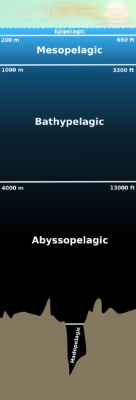
Mesopelagic
Encyclopedia
The mesopelagic (also known as the middle pelagic or twilight zone) is that part of the pelagic zone
that extends from a depth of 200 to 1000 metres (650 to 3300 feet) below the ocean surface
. It lies between the photic
epipelagic above and the aphotic
bathypelagic below, where there is no light
at all. Although some light penetrates this deep, it is insufficient for photosynthesis
. Though the temperature varies less at any one height than the epipelagic, the mesopelagic is the location of the thermocline
, and in warmer regions of the world the temperatures varies from over 20°C (68°F) at the top to around 4°C (39°F) at the boundary with the bathyal zone
. Animals such as swordfish
, squid
s, wolf eel
s, cuttlefish
, and other semi-deepsea creatures live here. Also, there is enough sunlight for animals, such as the chain catshark
, to be fluorescent.
Pelagic zone
Any water in a sea or lake that is not close to the bottom or near to the shore can be said to be in the pelagic zone. The word pelagic comes from the Greek πέλαγος or pélagos, which means "open sea". The pelagic zone can be thought of in terms of an imaginary cylinder or water column that goes...
that extends from a depth of 200 to 1000 metres (650 to 3300 feet) below the ocean surface
Sea level
Mean sea level is a measure of the average height of the ocean's surface ; used as a standard in reckoning land elevation...
. It lies between the photic
Photic zone
The photic zone or euphotic zone is the depth of the water in a lake or ocean that is exposed to sufficient sunlight for photosynthesis to occur...
epipelagic above and the aphotic
Aphotic zone
The aphotic zone is the portion of a lake or ocean where there is little or no sunlight. It is formally defined as the depths beyond which less than 1% of sunlight penetrates. Consequently, bioluminescence is essentially the only light found in this zone...
bathypelagic below, where there is no light
Light
Light or visible light is electromagnetic radiation that is visible to the human eye, and is responsible for the sense of sight. Visible light has wavelength in a range from about 380 nanometres to about 740 nm, with a frequency range of about 405 THz to 790 THz...
at all. Although some light penetrates this deep, it is insufficient for photosynthesis
Photosynthesis
Photosynthesis is a chemical process that converts carbon dioxide into organic compounds, especially sugars, using the energy from sunlight. Photosynthesis occurs in plants, algae, and many species of bacteria, but not in archaea. Photosynthetic organisms are called photoautotrophs, since they can...
. Though the temperature varies less at any one height than the epipelagic, the mesopelagic is the location of the thermocline
Thermocline
A thermocline is a thin but distinct layer in a large body of fluid , in which temperature changes more rapidly with depth than it does in the layers above or below...
, and in warmer regions of the world the temperatures varies from over 20°C (68°F) at the top to around 4°C (39°F) at the boundary with the bathyal zone
Bathyal zone
The bathyal zone or bathypelagic – from Greek βαθύς , deep – is that part of the pelagic zone that extends from a depth of 1000 to 4000 metres below the ocean surface. It lies between the mesopelagic above, and the abyssopelagic below. The average temperature hovers at about 39°F...
. Animals such as swordfish
Swordfish
Swordfish , also known as broadbill in some countries, are large, highly migratory, predatory fish characterized by a long, flat bill. They are a popular sport fish of the billfish category, though elusive. Swordfish are elongated, round-bodied, and lose all teeth and scales by adulthood...
, squid
Squid
Squid are cephalopods of the order Teuthida, which comprises around 300 species. Like all other cephalopods, squid have a distinct head, bilateral symmetry, a mantle, and arms. Squid, like cuttlefish, have eight arms arranged in pairs and two, usually longer, tentacles...
s, wolf eel
Wolf eel
The wolf eel is a member of the family Anarhichadidae together with the wolffishes of the genus Anarhichas. The wolf eel is monotypic within the genus Anarrhichthys. This superficially eel-like fish feeds on crustaceans, sea urchins, mussels, clams and some fishes, crushing them with its strong jaws...
s, cuttlefish
Cuttlefish
Cuttlefish are marine animals of the order Sepiida. They belong to the class Cephalopoda . Despite their name, cuttlefish are not fish but molluscs....
, and other semi-deepsea creatures live here. Also, there is enough sunlight for animals, such as the chain catshark
Chain catshark
The chain catshark or chain dogfish is a small, spotted shark that has a characteristic fluorescent activity. The species is common from George’s Bank in Massachusetts, to Nicaragua. The species is considered harmless and rarely encountered by humans...
, to be fluorescent.
See also
- Mesopelagic fish

